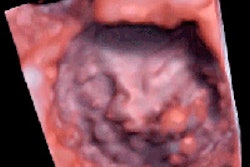TORONTO - Nuclear medicine physicians using a 3D software application that fuses SPECT myocardial perfusion images with coronary CT angiography (CTA) data saw an improvement in accuracy compared to viewing SPECT MPI images alone, according to a study presented by South Korean researchers at this week's SNM meeting.
Both SPECT-based myocardial perfusion imaging (MPI) and coronary CTA have disadvantages, according to Dr. Eun-Jun Kong from Yeungnam University Hospital in Gyeongsan. MPI is a proven technique but can underestimate the extent of coronary artery disease (CAD), and lacks anatomical information. Coronary CTA provides detailed anatomic information and has a high negative predictive value for significant CAD, but has difficulty evaluating patients with calcified vessels or stents, has trouble with distal vessels or side branches, and offers poor quality in overweight patients.
These disadvantages could be overcome through the use of image fusion using a commercially available software application (CardIQ, GE Healthcare, Chalfont St. Giles, U.K.). The researchers put the software to use in a multicenter trial with 49 patients who had reversible perfusion defects on myocardial perfusion scintigraphy (MPS).
Conventional MPS images were read by two nuclear medicine physicians, who then analyzed 3D SPECT/CTA fusion images produced by the software. Quantitative coronary angiography was used as the reference standard. A total of 147 coronary artery segments were analyzed in the patient population, of which 69 were positive lesions.
Ten lesions were missed only on MPS, while fusion imaging was able to exclude disease in four cases that were equivocal on MPS. Fusion imaging was able to correct corresponding allocated arteries in five lesions.
The researchers found that nuclear medicine physicians interpreting 3D SPECT/CTA images had a sensitivity of 82.7%, compared to 69.1% for standard MPS studies. They recorded a specificity of 80%, compared to 70% for conventional MPS. Positive predictive value with the 3D software was 84.8%, compared to 75.7% with MPS, and negative predictive value was 77.4%, compared to 62.7% with standard MPS.
Kong concluded by stating that the 3D software was able to add complementary information on coronary lesions and their impact on heart function, and made possible a comprehensive noninvasive assessment of patients.
Related Reading
Hybrid coronary CTA, SPECT offer less radiation, shorter scan time, June 15, 2009
Gated SPECT best indicator for cardiac events, April 13, 2009
ACC study: Most cardiac SPECT scans are appropriate, April 1, 2009
MRI, MDCT err in estimating cardiac functional parameters, February 20, 2009
Hybrid 3D echo/SPECT technique produces better coronary artery disease imaging, February 12, 2009
Copyright © 2009 AuntMinnie.com




















